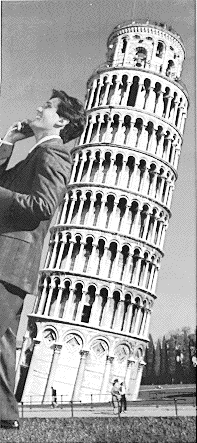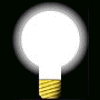
 |
Alternative Homework Assignment: Leaning Tower of Pisa |
One of the great folk legends in Physics is that of Galileo in the 16th century dropping a wood ball and an iron ball from the top of the Leaning Tower of Pisa to refute an Aristotelian belief that heavier objects fall faster. Although historical research indicates that this event probably never took place, the Tower itself is an interesting and famous work of architecture. It has a lean that is increasing slowly over the years as a result of the ground under one side settling faster than the ground on the other side. The following photograph of the tower was taken from an advertisement found in a 1994 airline magazine. Note that the photo of man talking on the telephone to the right is not part of the original photograph.
 |
(a) Examine the photograph. Take the measurements in centimenters
that are needed to find a scale factor that enables you to estimate the
length of the Tower in meters (i.e. its height if it were standing up straight.)
Use only evidence in the photograph. No other data are allowed. Then estimate
the tower length in meters.
(b) According to data published in Sir Bannester Fletcher's A History of Architecture (U. of London Athlone Press, 1975, p. 470) the diameter of the lower part of the Tower is 16.0 m. Using this data find another scale factor for estimating the length of the tower, and then re-estimate the length of the tower using this new scale factor. (c) Which of the scale factors (a) or (b) do you think will give the best estimate of the length of the Tower? Explain the reasons for your answer. (d) Using the scale factor you found in part (b) what is the length Tower without the Belfry or narrow top segment. (i.e. just consider the bottom 7 stories.) (e) Based on data also reported by Fletcher the top of the wide part of the Tower (with the narrow top segment omitted) overhangs the bottom by 4.2 meters as of 1975. Question: Is the lean of the tower exaggerated in the photo used in the ad? Are the little people in front of the tower dubbed in? Discuss this question and provide appropriate calculations and/or measurements to support your opinions. |
These problems written and collected by P. Laws. These problems may be freely used in classrooms. They may be copied and cited in published work if the Activity-Based Physics (ABP) Alternative Homework Assignments (AHAs) Problem site is mentioned and the URL given.
 |
Go back to the AHA page |
Maintained by
University of Maryland PERG
Comments and questions may be directed to
E. F. Redish
Last modified June 25, 2002